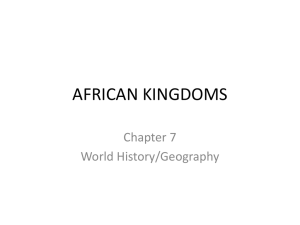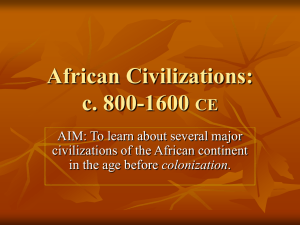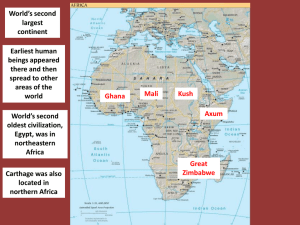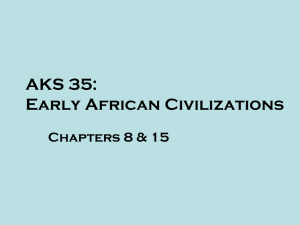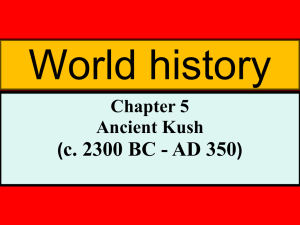************8
advertisement
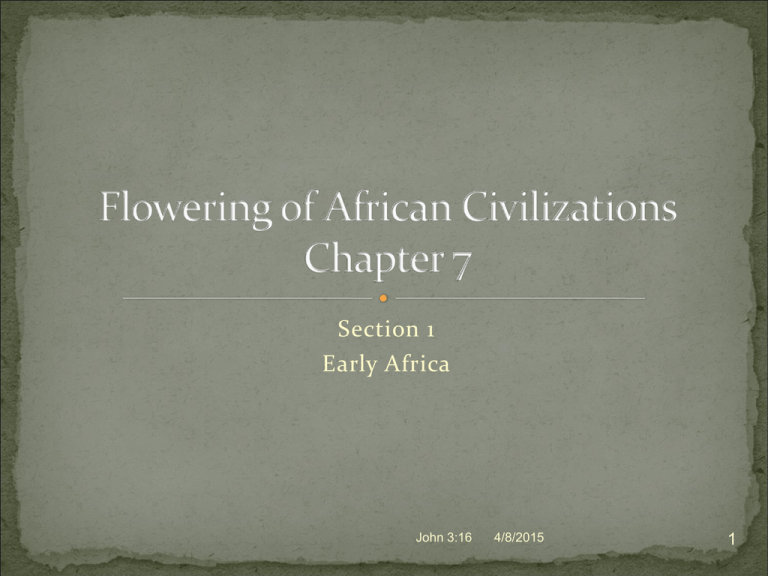
Section 1 Early Africa John 3:16 4/8/2015 1 A variety of societies and cultures emerge in early Africa 1500 B.C. to 1500 A.D. John 3:16 4/8/2015 2 Oral tradition Plateau Savanna Matrilineal Age set John 3:16 4/8/2015 3 Piankhi Ezana The Nok John 3:16 4/8/2015 4 Nubia Kush Axum John 3:16 4/8/2015 5 Left few written records Most information passed through oral traditions— legends and history passed from one generation to another by word of mouth Learned from legends and artifacts John 3:16 4/8/2015 6 Early African cultures developed technologies and trade based on regional natural resources Civilizations came and went, based movement of people and the way natural resources were developed John 3:16 4/8/2015 7 Multiple climates Three times the size of the United States Deserts Mountains Grasslands River valleys John 3:16 4/8/2015 8 North Africa East Africa West Africa Central Africa Southern Africa John 3:16 4/8/2015 9 North Africa—thin coastal plain, bordering the Mediterranean Sea and inland desert area Coastal Africa—mild temperature and lots of rain South of the of the “green belt”—a vast desert known as the Sahara—the world’s largest desert— extending 3,500 miles John 3:16 4/8/2015 10 A plateau—a relatively high, flat area Moderate rainfall Sustains the ‘savannas’—treeless grasslands—that cover the plateau The Sahara and the Sahel: 40% of Africa John 3:16 4/8/2015 11 Rising above the plateau are two major mountains Mount Kenya Mount Kilimanjaro John 3:16 4/8/2015 12 Major Rivers: Niger and Zaire Not well navigated Few natural harbors Limited river travel Foreign invasions difficult John 3:16 4/8/2015 13 Lush tropical rain forests—sunlight cannot reach the surface Further south—another desert—the Kalahari John 3:16 4/8/2015 14 Near equator is lush rainforest so think that sunlight can’t penetrate Still further south is highland in present-day country of South Africa The African continent has provided rich resources for its people Early cultures developed where rainfall was plentiful or near lakes or along rivers like the Nile John 3:16 4/8/2015 15 By 3000 B.C. a militarily skilled people established a kingdom called Nubia in the southern part of the Nile River Valley Mastered the bow and arrow Conquered neighbors John 3:16 4/8/2015 16 The Nubians maintained close contacts with Egypt to the north Archaeologists uncovered Nubian king tombs containing precious stones, jewelry, and pottery Some believe ideas like monarchy, eating utensils, boats, etc., were really Nubian ideas passed to the Egyptians John 3:16 4/8/2015 17 By 2000 B.C., the Nubian river civilization had developed into the kingdom of Kush, which was under Egyptian rule for 500 years They had been defeated in warfare by the Egyptians Egyptian pharaohs stationed troops in Kush to collect duties from goods moving through the area John 3:16 4/8/2015 18 The Kushite cites of Napata and Meroe stood where trade caravans crossed the Nile—great trade location Gold Elephant tusks Timber Kings grew wealthy John 3:16 4/8/2015 19 1000 B.C. Kush broke away from Egypt and became politically independent The Kushites under king Piankhi (pee.AHNK.hee) in 724 B.C. defeated Egypt in war and became rulers over both Kush and Egypt John 3:16 4/8/2015 20 Kush Kingdom Capital: Napata Sandstone temples Monuments Pyramids John 3:16 4/8/2015 21 Assyrains invade Egypt and easily defeat the Kushites Easily defeated the Kushites with iron weapons The Kushites moved back to their home— the bend in the upper Nile John 3:16 4/8/2015 22 Although the Assyrians in 671 B.C. easily defeated the Kushites, the Kushite kingdom, now based in the Upper Nile, managed to thrive for 150 years, becoming a major center for iron production They had learned iron making from the Assyrians Built this capability in Meroe—major center for making iron Built fine houses with courtyards modeled after those of Rome John 3:16 4/8/2015 23 Kushite kingdom thrived for 150 years New power—Axum— located near the Red Sea Invaded Kush Ended Kushite domination of northeastern Africa John 3:16 4/8/2015 24 The Kushites thrived for 150 years then the Axum invaded and conquered them Axum—located near the Red Sea Trading power Because of its Red Sea location Elements of the Roman culture John 3:16 4/8/2015 25 Christian conversion of King Ezana Two Christians from Syria shipwrecked and brought before the king Convinced Ezana to become Christian Christianity became dominant in Egypt and Kush too John 3:16 4/8/2015 26 A West African culture called the “Nok” established itself in the fertile Niger and Benue River valleys between 700 and 200 B.C., making use of metal to farm their land more effectively John 3:16 4/8/2015 27 As West African farmers produced more food, the population increased, eventually leading to widespread food shortages and a great migration that took small groups to the less populated areas of West Africa Over 1000 years this great migration took place John 3:16 4/8/2015 28 Axum declined after the rise of the religion of Islam during the A.D. 600s Axum’s rulers then set up the Christian kingdom of Ethiopia John 3:16 4/8/2015 29 Historians call this mass movement the Bantu migrations because descendants of the people who migrated throughout the continent share elements of a language group known as Bantu Did not follow a single pattern Following rivers Following rainforests Savannas etc John 3:16 4/8/2015 30 As people pushed into new areas, they met other African groups that adopted their ways of life In time, Bantu-speaking peoples became the dominate group in Africa south of the Sahara John 3:16 4/8/2015 31 Divided into hundreds of ethnic groups Each with its own religious beliefs, marriage and family customs, and traditions Communities formed into large households often from one set of grandparents Many villages were “matrilineal”-tracing their descendents through mothers John 3:16 4/8/2015 32 Boys and girls of similar ages Assigned jobs Boys 10-12: herded cattle Girls 10-12: plant, tend, harvest crops etc John 3:16 4/8/2015 33 All social laws and traditions were from one god Lesser deities flourished below the one god Storms Mountains Trees Spirits of dead ancestor lived with them John 3:16 4/8/2015 34 Sculptor was important art form Wearing of masks at ceremonial dances symbolized link between the living and the dead John 3:16 4/8/2015 35 Music rich in rhythm was woven into fabric of everyday life Music provided the motivation for doing tedious chores Variety of drums, harps, horns, etc. John 3:16 4/8/2015 36 Excelled in oral literature Passed down form one generation to the other Fables Histories Proverbs Traditions Values John 3:16 4/8/2015 37 Section 2 John 3:16 4/8/2015 38 Absorbed many customs and cultures from other lands—adopted many ideas Persian Indian European etc John 3:16 4/8/2015 39 Various arts developed throughout Bant-speaking Africa, including music rich in rhythm and sculpture created for ceremonial and everyday use; oral literature passed down from one generation to the nest recorded the past and taught traditions and values Wearing of masks in ceremonies symbolized the link between the living and the dead Rhythm often provided the motivation for digging ditches and doing other laborious work Variety of drums used Oral literature taught traditions and values John 3:16 4/8/2015 40 Chapter 7, Section 2 John 3:16 4/8/2015 41 Trade was an important aspect of society in West Africa John 3:16 4/8/2015 42 Monotheism Ghana Mosque John 3:16 4/8/2015 43 Sundiata Keita Mansa Musa Askia Muhammad John 3:16 4/8/2015 44 Ghana Mali Timbuktu Songhai John 3:16 4/8/2015 45 The kingdom of Ghana became one of the richest trading civilizations in West Africa due to its location midway between Saharan salt mines and tropical gold mines The kings of Ghana imposed taxes on goods that entered or left their kingdom John 3:16 4/8/2015 46 The kings of Ghana controlled the trading empire that stretched more than 100,000 square miles They also prospered on the goods that entered and left their kingdom “Ghana” meant “king” and because they ruled such a vast empire they named the land Ghana John 3:16 4/8/2015 47 There ways two-way trade traffic by caravan between cities in North Africa and Ghana Northern traders from North Africa Cloth Metelware Swords Salts From Ghana Kola nuts Farming produce Gold John 3:16 4/8/2015 48 Merchants leave goods on the ground and depart the area People bring gold and leave it on the ground beside the merchandise The merchant returns and if the gold is enough, they take it…if not they depart again the buyer returns with more gold if they want the merchandise John 3:16 4/8/2015 49 Ghana reached the height of its economic and political power as a trading kingdom in the A.D. 800s and 900s; the salt and gold trade moving through Ghana brought Islamic ideas and customs to the kingdom John 3:16 4/8/2015 50 Salt was an important trade item for the people of Ghana, who needed it to preserve and flavor their foods Salt and other items moving through Ghana brought Islamic ideas and customs. Most converted to Islam John 3:16 4/8/2015 51 At the end of the A.D. 1000s an attack on the Ghana trade centers by the Almoravids, a Muslim group from North Africa, led to the decline of Ghana as a prosperous kingdom Prosperous kingdom groups broke away to form smaller Islamic states John 3:16 4/8/2015 52 Mali, one of the states to break away from Ghana, became a powerful kingdom that eventually ruled much of West Africa Mali: “where the king resides” Ruled over the former kingdom of Ghana John 3:16 4/8/2015 53 Sundiata Keita: began to conquer surrounding territories and restored the trans-Saharan trade in gold and salt and restored agricultural production previously interrupted by the Almoravids Agriculture prospered and kings were able to collect taxes on surplus food John 3:16 4/8/2015 54 Mali’s greatest king A.D. 1312-1332 Opened and protected trade routes and introduced Islamic culture John 3:16 4/8/2015 55 On his pilgrimage to Makkah, he took 12,000 slaves each dressed in silk and brocade and carrying gold bars He gave away so much gold, prices fell world wide Persuaded a Spanish architect to built mosques and a palace in Timbuktu Became a center for Muslim art and teaching John 3:16 4/8/2015 56 Following the death of Mansa Musa Attacked by Berbers From Saharan region of the north Captured Timbuktu Also, the attack came from inside the kingdom, and people living in the Songhai region of the Niger River Valley rebelled against the empire Ultimately, Mali split into several independent states John 3:16 4/8/2015 57 The rebellious Songhai, who were skilled traders, farmers, and fishers, were led by strong rulers who managed to conquer the cities of Timbuktu and Djenne “Led by then current leader, Sunni Ali When he died, Ali’s son inherited the kingdom, The Muslims overthrew him and installed a Muslim ruler John 3:16 4/8/2015 58 Under the leadership of Askai Muhammad The Songhai Empire reached its height of glory Divided empire into 5 provinces and installed governors Maintained the peace through cavalry and navy Timbuktu became center of Muslim learning John 3:16 4/8/2015 59 Introduced laws based on the teachings of the holy book of Islam, the Quran Lesser crimes sometimes overlooked Punishment harsh on serious crimes like robbery or idolatry Appointed Muslim judges to support Muslim laws John 3:16 4/8/2015 60 Askai Muhammad overthrown By his son Led to a series of struggles for the thrown Weakened central government Moroccan army invades with guns and cannon Easily defeats the Songhai and the empire comes to an end John 3:16 4/8/2015 61 Chapter 7 Section 3 John 3:16 4/8/2015 62 Areas in East, Central and Southern African developed as a result of inland and overseas trade John 3:16 4/8/2015 63 Monopoly: sole control or ownership Multicultural: a variety of cultural groups John 3:16 4/8/2015 64 Kilwa Malindi Mombasa Sofala Zanzibar Karanga Great Zimbabwe John 3:16 4/8/2015 65 East Africans sailed with the monsoon winds across the Indian Ocean to trade with the Arabian Peninsula and South Asia; A.D. 900s, Arab and Persian merchants had settled on the East African coast and controlled the trade there Africans traded with: ivory, gold, iron, and rhinoceros horn Indians traded with: cloth and porcelain John 3:16 4/8/2015 66 By A.D. 1200 small East African trading settlements had become thriving city-states taxing the goods that passed through their ports The port of Kilwa had a virtual monopoly of the gold trade with the interior Malinda and Mombasa were also important centers. Sofala, in current day Mozambique was as well John 3:16 4/8/2015 67 The island of Zanzibar was also an important center of trade, drawing sailors from Southwest Asia as well as India and China—seeking evory and gold from city states of East Africa John 3:16 4/8/2015 68 By the A.D. 1300s the city-states of East Africa had reached the height of their prosperity; they were multicultured centers in which Islamic and African cultures blended Arab and Persian merchants ruled the trading states. They converted many African to Islam John 3:16 4/8/2015 69 Arab merchants married local women who had converted to Islam, families with both African and Islamic members began speaking Swahili, and the people of the East African coastal city-states developed an Arabic form of writing to record their history The spoken language was a Bantu language that included Arabic and Persian words John 3:16 4/8/2015 70 Indian Ocean trade reached far inland, contributing to the rise of wealthy Bantu kingdoms in Central and Southern Africa; traders from the coast exchanged foreign goods—silk, porcelain, glass beads, carpets, and pottery--with people in the central regions for minerals, ivory, coconut oil, and enslaved Africans John 3:16 4/8/2015 71 Between A.D. 1000 and 1500, the people of the bantu kingdom Karanga built nearly 300 stonewalled fortresses throughout their territory, the largest of which was called the Great Zimbabwe—meaning “stone houses” The oval stone wall of the Zimbabwe enclosure was 30 feet high John 3:16 4/8/2015 72 For nearly five centuries, the Bantu states grew wealthy from control of the chief routes between the gold mines and the sea; in the A.D. 1400s, however, Bantu states waged civil wars that brought disorder and disrupted trade John 3:16 4/8/2015 73 In time, the Changamire Empire took over Great Zimbabwe and built the fortress’s largest structures; at the same time, European explorers arrived on the coast, eager to control sources of gold, ivory, and copper The Europeans posed challenges to the survival of the African civilizations in the continent’s interior John 3:16 4/8/2015 74
